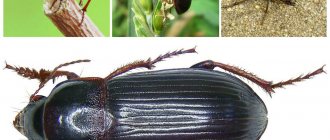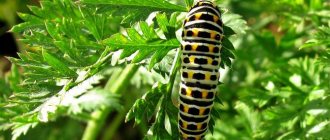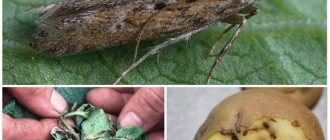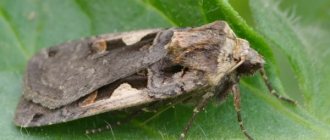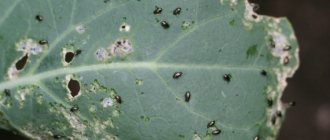Who are they?
Slugs are atypical gastropods. Evolution has deprived animals of a protective shell - its soft body is protected from drying out only by mucus, which is constantly produced by the secretory glands of the creature. Because of such a slippery surface, the mollusk was called a slug.
You can recognize it by its characteristic cream or beige color, pronounced head with two horns. You can tell that a slug has visited your cabbage heads by the recognizable silvery trail on the leaves - these are traces of mucus secreted by the mollusk.
Because of their vulnerability, they prefer to settle in shady and damp places - these are the top layers of soil, wood, plant debris, humus, etc. Naturally, high temperatures, as well as direct sunlight, are destructive for them - a good natural method of combating slugs on cabbage. The mollusks are most active in the evening and at night, when the sun sets below the horizon and the air cools - that’s when they come out to feast on white cabbage victims.
How dangerous are slugs and snails for cabbage?
Slugs are gastropods whose body is completely covered with glands that secrete mucus. They are comfortable at moderate temperatures (18°-22°C) and humid air. Slugs eat a lot: the daily ration of food they consume is 40 times their own weight. The slug loves cabbage. But make no mistake: he does not wait for the cabbage to form a head, but attacks it immediately, already at the seedling stage. At first, irregularly shaped holes will appear on the leaves, and when they turn into a sieve, the slug will take hold of the thick parts, gnaw through deep cavities and destroy the entire cabbage.
Spoiled harvest is not suitable for storage for several reasons:
- the slugs remaining in the cabbage continue to damage it, which leads to rotting of the vegetable;
- With mucus and excrement, pathogenic bacteria, viruses, helminth eggs and pathogenic fungi get onto the leaves, since slugs feed not only on plant foods, but also on fungal spores.
Slugs are hermaphrodites (they have both female and male principles). They require cross fertilization. They find each other by smell and actively reproduce in conditions of high humidity. On average, up to 500 eggs laid by one slug overwinter under stones, in the ground, under remaining debris.
About the dangers of slugs
Why are many gardeners so concerned about ways to combat slugs on cabbage? The reason is a certain harm of defenseless shellfish:
- Small slugs are extremely voracious. And at the same time, white cabbage is not their only favorite “dish”. They are not averse to eating cauliflower, broccoli, and Beijing. Insects will not refuse strawberries, wild strawberries, tomatoes, cucumbers, grapes and potato tops.
- The slug’s activity not only makes the cabbage leaf inedible, but also causes significant harm to the plant - its mucus paths clog the respiratory tubules.
- Slugs are also carriers of harmful viruses and microorganisms. In this case, the disease sometimes affects not only cabbage alone, but also plants growing in neighboring beds.
What do slugs look like?
Their detailed description will help to distinguish these pests from snails:
- the slug is large in size and does not have a shell “on its back”;
- he moves slowly, covering distances with difficulty;
- the head of the mollusk is “decorated” with 3 horns; when he moves, he moves them;
- The color of the pest can be different - from brown to dark gray.
Parasites eat cabbage leaves; they have powerful jaws, so they quickly destroy the planting.
If you examine the heads of cabbage, you can find the “movements” that pests make in them.
Fighting slugs on cabbage with folk remedies
Our ancestors knew how to deal with pest mollusks using improvised means. Let us present to you their effective methods:
- Tobacco, sulfur, ash. These substances should be scattered into special grooves distributed along the entire perimeter of the bed. The smell they emit is unpleasant for slugs, and getting the product on their body causes a severe burn. However, this method has one drawback: after the rain, the “protective strip” must be renewed.
- Mulching. A more modern way. Cover the bed with film so that the path for the mollusks remains clear. The resulting condensation and humid atmosphere will attract slugs to this trap at night. But the greenhouse effect during the day, under the rays of the sun, will certainly cause the death of pests.
- Hot pepper, lime. Edge the bed with grooves containing one of these components. When a slug gets on particles of lime or pepper, it gets a severe burn, leading to its death.
- Table vinegar or mustard powder. Stir 1/2 cup of table vinegar in 10 liters of water - the substance can be replaced if desired with mustard powder (150 g per bucket of water). The fight against slugs on cabbage is simple here - treat the plantings with a solution, paying special attention to the tops of the heads of cabbage.
- Nettle. It is destructive to slugs due to its stinging effect, affecting their delicate bodies. Wrap the legs of the plantings with fresh nettle leaves - experienced gardeners believe that this will completely deprive the cabbage of uninvited guests.
Effective methods of destruction
Despite their external defenselessness, it is difficult to compete with them. Such activities must be carried out systematically and comprehensively. And even if you get rid of pests at once, there is a possibility of them moving from neighboring areas. Gardeners practice methods of protecting cabbage from voracious pests:
- Mechanical methods - setting traps, baits, manual collection.
- Agrotechnical methods - loosening, digging up soil, removing weeds and post-harvest residues.
- Chemical means of destruction - the use of molluscicides.
- An ecological method is to attract natural enemies of slugs: birds, grass snakes, shrews. It’s great if a gray toad is on duty near your cabbage beds, and a hedgehog visits at night.
Which of these methods you choose is up to you, but use the environmental method in any case: it is effective and safe.
Manual cleaning
Slugs are afraid of burns from direct sunlight, so they hide on hot days in secluded, damp places: under stones, earthen clods, heaps of weeds left for a long time and leaves of plants creeping along the ground. But, precisely during the daytime, when they concentrate in certain places, they are easy to detect and collect manually. This is a labor-intensive process, but the benefits are great.
Folk remedies
Folk methods used by summer residents are effective and efficient. Some of them do not harm the mollusks themselves, but simply repel them. Slugs can be removed using substances that they are afraid of:
- salt;
- nettle;
- mustard;
- ammonia;
- superphosphate;
- coffee;
- hot pepper.
All these substances irritate the protective mucous layer of the mollusk and burn it.
Folk remedies, first of all, mean the use of recipes for various infusions for watering and spraying:
- 200 g of chopped garlic is poured into 10 liters of water and left for 24 hours. The prepared solution is sprayed onto cabbage leaves.
- Pour a glass of ash into a bucket of water, add half a piece of laundry soap and stir.
For watering:
- 1 kg of dry delphinium leaves is poured into 10 liters of water and left for 2 days.
- 1 kg of fresh (0.5 kg of dry) hot pepper pods is poured into a bucket (10 l), left for three days, boiled, then left for another two days and watered the plants.
A good folk remedy is dusting cabbage leaves and soil with wood ash.
Expert opinion
Stanislav Pavlovich
A gardener with 17 years of experience and our expert See also White cabbage: planting and care in open ground
Ask a Question
Advice! Folk remedies are effective when cabbage beds are not inhabited by huge colonies of voracious slugs. Otherwise, you should resort to radical methods.
As for planting spices (cilantro, parsley, nasturtium) near or around cabbage, this hardly seems to be a serious matter. If they help, it will most likely only be for a season, since slugs even adapt to poisons, and after a few generations they stop reacting to them altogether.
Ammonia
Ammonia is a remedy that helps get rid of snails and slugs. Ammonia is a nitrogen compound, so such watering is beneficial for plants. Especially during the early growing season, when they need nitrogen-containing fertilizers. To protect the cabbage 4 tbsp. l of ammonia is diluted in 10 l of water. Water the plant and the soil underneath it.
Mustard, salt and pine needles
Regular table salt helps fight slugs. Many, trying to save the harvest, spray cabbage leaves with saline solution, water them at the roots, and scatter them on the beds. Should not be doing that. Plants do not tolerate salt well and may dry out. Treat the basement where slugs have entered with it. Make a solution in the following proportion: 1 glass of salt per 10 liters of water, pour it into a sprayer and spill the entire subfloor.
Needles are an excellent mulch for cabbage. Small spines will prevent slugs from getting to the vegetables. If it is not possible to mulch the beds, place several branches around the plants. But this will only work if the flooring is constantly updated.
Dry mustard is considered a reliable and proven remedy in the fight against slugs and snails. It is used as a solution for spraying cabbage. Place 70 g of mustard powder in 1 liter of water, leave for an hour, dilute 4 times and spray the plants with it.
Beer
Gardeners are wondering: “Is it true that slugs on tomatoes love beer? And how to apply the product: pour it on the pests from above, or present it on a silver platter?” We answer. Yes, slugs and snails love beer, but you don’t need to water or spray them.
Every 40 cm around the perimeter, place bowls filled 3/4 with beer. The containers can be anything. It is important that their rim is flush with the soil surface. At night, the slugs will follow the smell, easily overcome a small barrier and fall into the beer pool.
We treat with chemicals
All methods are good in the fight against slugs and snails, but the use of chemicals is a last resort. A cabbage patch is not a flower garden, and no matter how we are convinced, there is still a possibility of poison entering the human body. Molluscicides based on metaldehyde are used against slugs and snails (Slug Eater, Stop. Snail, Thunderstorm).
The granules are scattered on the surface of the soil between rows and on paths. These drugs have attractive activity and can attract the attention of not only slugs, but also other inhabitants of the garden, including pets.
Expert opinion
Stanislav Pavlovich
Gardener with 17 years of experience and our expert
Ask a Question
Advice! If there are cats or dogs roaming around the area, and you can’t do without chemicals, take a child’s Kinder Surprise, make a few holes in it and place granules there. Animals will not be able to get the poison, and slugs will crawl inside.
The use of chemicals also has a detrimental effect on the soil, changing its composition and killing microorganisms. But, if you use similar means of combating slugs, then use the drugs 20 days before harvesting.
Storm
"Groza" is a generic version of the drug "Meta" from a Swiss company. Widely known and popular in Russia as a productive means of protecting cabbage from slugs. Available in the form of blue granules. Capable of destroying shellfish if ingested after 2 hours. Death occurs from food poisoning.
The product lasts 2-3 weeks and does not lose its properties after rain. It is recommended to start treatment with “Thunderstorm” in the spring to protect young seedlings. Granules are scattered between rows and on paths. It is unacceptable to get them inside the cabbage. The substance is poisonous. It should not be used in rooms where crops are stored. To use slug repellent on the site, use 30 g of the substance per 10 square meters. m of land. During the growing season, cabbage is processed 2-3 times.
Metaldehyde
Metaldehyde is considered an effective remedy against slugs and snails. When it hits the mucus, it destroys it, and then penetrates the skin and kills it. After heavy and frequent rains, the influence of metaldehyde weakens, so manufacturers recommend poisoning slugs and snails in clear, dry weather.
See also How to fertilize cabbage after planting in open ground
The drug is granular, consumption: 15g per 5 square meters. m plot. Belongs to hazard class 3 (moderately dangerous). It will not harm fish and worms, but it is dangerous for animals, although manufacturers claim that it contains bitter additives that repel dogs. The area should be treated 2 times per season.
Setting up traps
In order to make their work easier and not look for the secret habitats of slugs, gardeners prepare traps for them - places where they lure unsuspecting individuals, and then easily collect them for destruction. Beer and kvass traps are popular among gardeners. Slugs also love cider and fermented apple juice.
Of course, it is not alcohol that attracts pests, but glucose. Therefore, instead of beer, they use another means of protecting cabbage: pour water into a plastic container with a lid, add sugar, flour and yeast. At a distance of 3-4 cm from the bottom, holes are made around the perimeter of the container for slugs to penetrate inside. The bowls are not buried in the ground, just sprinkled with a little earth for stability. After 3 days the composition is changed.
Corn flour is also good at fighting slugs on cabbage. It is placed in a glass liter jar, laid horizontally among the heads of cabbage.
Creation of false shelters
Given the slugs’ affinity for damp places under various objects, summer residents recommend creating false shelters. They do it like this:
- Dry the designated piece of land without watering it for a week.
- Abundantly moisten the soil of the site.
- False shelters are placed at a distance of 3 meters from each other - boards, pieces of plywood, slate, metal. It could be plastic, wet burlap, thick cardboard, huge burdock or pumpkin leaves.
- Bait is placed next to the trap: pumpkin, zucchini peels, lettuce or cabbage leaves. Placing crushed slugs or snails in the trap gives good results.
- During the day, slugs are picked out by hand and destroyed by placing them in a bucket with lime, salt or a mixture of water and kerosene.
- Move shelters to a new location.
The process is repeated 4 times during the vegetable season. As a result, it is possible to remove large populations of pests from the site.
Obstacle in the form of ditches
Often, special obstacle courses are created around planted plants to prevent pest molluscs from entering the area. Substances and objects that interfere with the movement of slugs are used as barriers. Along the perimeter of the site, embankments are made of pine needles, crushed nut shells, gravel, and fine-grained sand.
Many summer residents complain that these products do not help protect cabbage. The mistake is that the stripes are too narrow. The substance used burns the shell of the animal, the mucous cocoon slides off, but the pest manages to get across the path. The stripe should be wide. It is also advisable to choose more than one slug repellent, but mix them. For example:
- Nettles are laid along the perimeter of the bed;
- sprinkle superphosphate or soda on top.
Next they make layers of coffee and Christmas tree needles. The main thing is that its total width is at least 25-30 cm. And then the enemy will not get through.
Sauna effect
Gardeners speak highly of the method that allows you to create a sauna on your property. To create this effect, the soil under the cabbage heads is covered with pieces of polyethylene. They do this in the evening. By morning, dew forms under the cellophane, and the slugs rush into the warmth and moisture. However, with the appearance of the sun, paradise life ends, and soon they die under its scorching rays.
Universal means
We’ll also tell you about folk remedies that will save not only cabbage from slugs:
- Salt. A good remedy for compost heaps - salting the beds is not very useful. Sprinkle the powder on the silver slime trails, and soon you will no longer encounter uninvited guests.
- Soda Ash. The easiest method is to sprinkle the powder on the clam collection. They will die in a few seconds. To treat plants, it is better to prepare a soda solution: 50 g of soda, 20 g of laundry soap shavings per bucket of water.
- Ammonia. Fighting slugs on cabbage with ammonia is quite dangerous for the plant - under no circumstances spray the solution on its leaves, roots, or stem, but treat only the soil. The solution is simple to prepare - 2 liters of ammonia per 10 liters of water (full processing, for selective processing you can limit yourself to 1 liter of solution).
Pine needles, vinegar, and mustard will also help protect plants from pests.
Chemicals
If you are determined to decisively fight slugs on cabbage, then we present to your attention effective chemicals:
- "Storm". The product was created specifically for the destruction of slugs and snails. The active substance here is metaldehyde. Appearance: bluish granules. The mollusk readily eats them, and the effect of the components on its body leads to the death of the pest. The product remains harmless for birds, mammals, and earthworms.
- "Meta". The drug is also created on the basis of metaldehyde and is effective if it gets inside the body of a mollusk. You need to find places in the garden where there are large concentrations of pests and scatter the product near them. Approximate consumption - 15 g/15 m2.
- Metaldehyde. The pure substance itself is also an excellent pest repellent. But in such a concentration it is a strong poison, including for humans! Therefore, cabbage should be treated with metaldehyde solution at least 3 weeks before harvesting. If the substance is in granules, then you should scatter several pieces under the legs of the plantings.
Traps
Some gardeners believe that effective control of slugs on cabbage is by setting simple traps:
- Near the favorite habitats of slugs, place pieces of plywood, slate, wood, under which it will be convenient for the mollusks to climb. Now you will only need to bypass these traps and collect the slugs nestled under them.
- Place jars of liquid on the cabbage bed - kvass, fermented compote, beer. The smell will definitely attract slugs, but not only them - beneficial insects can also fall victim to such a trap.
Preventive measures
In order not to proceed to measures to combat slugs on cabbage, the easiest way to prevent their appearance is:
- Plant cabbage sprouts at some distance from each other - otherwise the “roof” of densely spaced leaves will be an ideal place of residence for mollusks. If planted frequently, slugs will be more difficult to detect.
- Cover early varieties with film. High temperatures, which provide the greenhouse effect, are detrimental to the pest. But this method is not suitable for late varieties - it can lead to rotting of the roots.
- Water the plantings with water heated in the sun to high temperatures - this will not harm the plant, but it is destructive for the delicate bodies of slugs.
- Make sure that the bed is not surrounded by tall grass.
- Apply mineral fertilizers (superphosphate, potassium salt) regularly and on time - you can simply scatter them over the garden bed.
- Make a border around the perimeter of the bed from coarse sand, crushed eggshells, crushed shells, sharp nut shells - the slug's delicate belly will not overcome these obstacles.
You can fight slugs in many effective ways, which we introduced you to. However, it is still safer and easier to prevent their appearance in the beds.
Description of the pest
From a purely biological point of view, slugs are gastropods, lacking a shell that would protect them from external influences. The slug has a soft, elongated body that is constantly under a layer of mucus. It is produced by special glands.
When a slug moves, and this happens by contracting its torso, a layer of mucus remains behind. When wet it is transparent, but once it dries it takes on a silvery tint.
The body color of the slug is beige or brown and fairly uniform. The head is clearly defined and “decorated” with horns that look like tentacles. For a slug, this is a sensory organ.
The mollusk lives in the upper layers of the earth, plant debris, woodpiles and other places where humidity is high. The slug does not tolerate high air temperatures well, and therefore is forced to hide in the shade from the direct rays of the sun. They appear mainly at night, when the life-giving coolness sets in, and they eat cabbage leaves.
Slugs are very harmful, because if they appear, they can cause irreparable damage to the entire crop. They love all types of cabbage:
- white cabbage;
- broccoli;
- colored;
- Brussels sprouts;
- Beijing
The pest is not picky, appears only at night and can feed on other garden crops: tomatoes, strawberries, cucumbers and strawberries. In some cases, they can even handle potato tops and grape leaves. But slugs don’t like mustard. The mollusk will find a saving place for wintering in cabbage heads that were not harvested in the fall.
The danger of a slug is not only that it devours plants in the garden. It is also a carrier of harmful bacteria, viruses and dangerous diseases, which negatively affects productivity, so the pest must be destroyed.

